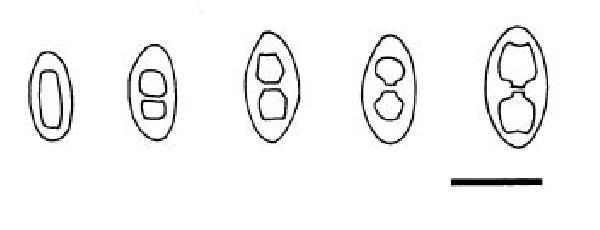Endohyalina insularis (Arnold) Giralt, van den Boom & Elix
Mycol. Prog., 9: 44, 2010. Basionym: Buellia saxatilis f. insularis Arnold - Verh. zool.-bot. Ges. Wien, 46: 119, 1896.
Synonyms: Rinodina insularis (Arnold) Hafellner
Distribution: N - TAA (Rambold & al. 1994, Giralt & Llimona 1997). S - Si (Brackel 2008c)
Description: Thallus crustose, lichenicolous, at first not visible, later sometimes consisting of thin, 0.3-0.5 mm wide, brown areoles. Apothecia lecideine, 0.2−0.4(-0.7) mm across, immersed in the host thallus to adnate, scattered to contiguous, with a black, flat disc and an entire, finally often excluded proper margin. Proper exciple 40-60 μm thick, Aethalea-type, the inner hyphae hyaline, prosoplectenchymatous, the outer hyphae parallel and usually strongly brown-pigmented; epithecium 5-10 μm high, dark brown, K-, N-; hymenium colourless, not inspersed with oil droplets, 50-80 μm high; paraphyses coherent, 1.5-2 μm thick at mid-level, the apical cells 3-6 μm thick, with brown caps; hypothecium brown, 110-120 μm thick, K-. Asci 8-spored, clavate to cylindrical-clavate, the apical dome K/I+ dark blue with a pale, conical-pointed apical cushion (axial mass), the wall I-, but the thin outer gel I+ blue, Bacidia-type. Ascospores 1-septate, brown, ellipsoid, 10-15(-17) x 5-7(-9) μm, Dirinaria-type, the wall thickened at apex and at septum, strongly warted. Photobiont chlorococcoid. Spot tests: K-, C-, KC-, P-, UV-. Chemistry: diploicin (major), isofulgidin (trace), fulgidin (trace).Note: a widespread, but apparently rare species described from South Tyrol, with a highly reduced thallus and an obligately lichenicolous growth on species of the Glaucomaria rupicola-group on siliceous rocks; to be looked for in other parts of the country.
Growth form: Crustose
Substrata: rocks
Photobiont: green algae other than Trentepohlia
Reproductive strategy: mainly sexual
paras Glaucomaria rupicola s.lat.
Commonnes-rarity: (info)
Alpine belt: absent
Subalpine belt: extremely rare
Oromediterranean belt: absent
Montane belt: very rare
Submediterranean belt: absent
Padanian area: absent
Humid submediterranean belt: absent
Humid mediterranean belt: absent
Dry mediterranean belt: absent

Predictive model
Herbarium samples
Growth form: Crustose
Substrata: rocks
Photobiont: green algae other than Trentepohlia
Reproductive strategy: mainly sexual
paras Glaucomaria rupicola s.lat.
Commonnes-rarity: (info)
Alpine belt: absent
Subalpine belt: extremely rare
Oromediterranean belt: absent
Montane belt: very rare
Submediterranean belt: absent
Padanian area: absent
Humid submediterranean belt: absent
Humid mediterranean belt: absent
Dry mediterranean belt: absent

Predictive model
| Herbarium samples |
 INDEX FUNGORUM
INDEX FUNGORUM
 GBIF
GBIF
 DOLICHENS
DOLICHENS



